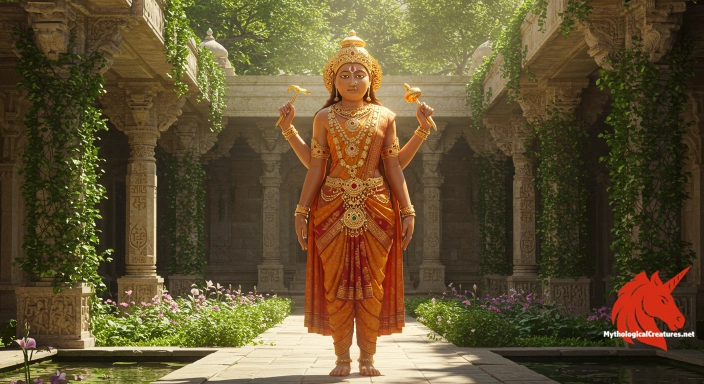Shindaw: Shindaw is one of the 37 nats in the Burmese pantheon, depicted as a young novice monk who died from a snake bite.

Shindaw
Shindaw - One of the 37 nats, Shindaw embodies the tragic transformation from a mortal monk to an immortal spirit within Burmese folklore.
Origins & First Encounters
Shindaw is a distinctive figure in the Burmese pantheon, revered as one of the fabled 37 nats. Born as a young novice monk from the historic city of Innwa, his life was dedicated to spiritual discipline and the quest for enlightenment. His untimely demise by a snake bite has come to symbolise the delicate balance between human endeavour and nature's unpredictable forces. The narrative of his life is interwoven with both Buddhist ideals and animist traditions, creating a unique synthesis that has captivated generations. His story is one of both tragic loss and transcendental transformation, embodying the belief that even in death, the spirit can attain a revered status. Ancient temple traditions and oral recountings attest to his role as a bridge between the mortal realm and the divine cosmos. The early records of his tale highlight the integration of monastic meditation with local spiritual practices, cementing his place among the revered nats. Shindaw’s legacy continues to inspire both sorrow and hope, underscoring the enduring cultural significance of his brief yet impactful life.
Source Texts & Tale Variants
The principal accounts of Shindaw’s life are preserved in a mosaic of primary sources that include temple inscriptions, ritual narratives, and oral traditions passed from one generation to the next. Although formal written records are limited, his legend permeates the cultural memory through song, dance, and traditional performance during nat festivals. In manuscripts and ancient carvings, the details of his transformation from a mortal novice to a celebrated nat are carefully chronicled. Each variant of the story emphasises different aspects of his life, from the pious practices of his monastic days to the mysterious circumstances of his fatal snake bite. Some local sources imbue his encounter with the natural world with spiritual symbolism, while others focus on the redemptive power of his suffering. Over time, these narratives have been adapted and enriched by storytellers and ritual specialists, ensuring that the essence of his character remains vibrant. The multiplicity of accounts reflects a living tradition in which the boundaries between historical record and myth are fluid. In this way, Shindaw’s story serves as a continuous thread in the tapestry of Burmese folklore, reaffirming his place in the sacred pantheon.
Form & Powers
Artistic portrayals of Shindaw emphasise a blend of youthful serenity and solemn symbolism, making him instantly recognisable within the pantheon. He is invariably depicted standing on a carefully sculpted pedestal, a visual metaphor for his ascension from mortal life to the realm of the divine. His head is adorned with a traditional Burmese headpiece that reflects intricate local artistic styles and a deep cultural heritage. Draped in a luminous yellow robe reminiscent of the vestments worn by Buddhist novices, he exudes both purity and spiritual commitment. The depiction is further enriched by his right hand holding a delicately rendered fan, which symbolises the gentle dispelling of worldly distractions. In contrast, his left hand clutches rosary beads, underscoring his steadfast devotion and meditative practice. His calm expression and composed posture serve to reinforce the narrative of a life devoted to inner peace, despite its tragic end. Such detailed iconography has not only defined his physical identity but has also cemented him as an enduring emblem of faith and transcendent beauty.
Regional Faces
Although Shindaw’s core legend is firmly rooted in the Burmese cultural landscape, regional interpretations highlight an intriguing array of local adaptations and rich variations. In various parts of Burma, subtle differences emerge in his portrayal, including slight alterations in the vibrancy of his yellow robe or the style of his headwear, each adjustment echoing unique regional aesthetics. In some communities, his image is interwoven with indigenous animistic elements that stress his connection to nature and natural forces. Local festivals and rituals may incorporate distinctive performance styles and musical accompaniments that subtly shift the focus of his narrative. The fan and rosary beads, integral to his depiction, are sometimes reinterpreted to align with local symbolism of protection and wisdom. Even the pedestal upon which he stands can differ in ornamental detail, reflecting regional artistic heritage. Despite these variations, the essence of Shindaw as a symbol of youthful devotion and tragic fate remains consistent. This adaptability underscores the dynamic way in which localized traditions and broader cultural currents shape and sustain his myth.
Cultural Parallels
When examined alongside similar figures across world mythologies, Shindaw emerges as a resonant symbol of youthful sacrifice and divine transformation. His narrative shares thematic parallels with tragic heroes and saints whose lives end abruptly yet yield eternal spiritual significance. Figures in other traditions, such as the poignant martyrs in Christian lore or the enigmatic yurei in Japanese folklore, similarly embody the transition from a mortal existence to a revered spiritual state. His blend of monastic vigour and supernatural destiny echoes the stories of youthful ascetics who, though marred by early demise, achieve a form of immortality through legend. The symbolic use of specific artefacts, like the fan and rosary beads, finds echoes in various cultural depictions where ritual objects serve as conduits of spiritual power. Such comparative analysis reveals a universal pattern; the intertwining of personal loss with broader metaphysical truths is a story told across continents. Shindaw’s character, therefore, can be seen as part of a larger narrative tradition where the ephemeral nature of life is celebrated and ennobled through myth. This cross-cultural dialogue enriches our understanding of how societies interpret the passage from life to deification.
Legacy & Modern Evolution
Over successive generations, the portrayal of Shindaw has evolved from a strictly local sacred figure into an enduring symbol that transcends both time and place. Traditional depictions, rooted in the immediate context of Innwa and Burmese festivals, have gradually incorporated modern artistic influences, ensuring his narrative remains contemporary and accessible. His image now frequently features in a broad array of media, from classical temple murals to modern exhibitions and cultural festivals. Artists and performers continue to reinterpret his story through dance, theatre, and visual arts, weaving together historical reverence with innovative expression. The shift in his portrayal underscores an ongoing dialogue between the ancient and the modern, where timeless themes of piety, sacrifice, and transformation are recast in new forms. In today’s cultural landscape, Shindaw is celebrated not only as a tragic figure but also as a beacon of spiritual resilience and ethical commitment. Modern reinterpretations often highlight his youthful innocence juxtaposed against profound life lessons, resonating with audiences who grapple with contemporary dilemmas. In this way, his legacy endures as a vibrant symbol of Burma’s rich mythological heritage, continuously inspiring and challenging both the faithful and the culturally curious.
Interesting Fact
Despite his tragic demise, Shindaw is venerated for symbolising the fusion of Buddhist practice with indigenous spirit worship, highlighting a unique aspect of Burmese cultural syncretism.
Quick Creature Info
Origin:
Our Mythic Legendary Rating:

Also Sometimes Known As:
Habitat:
Supernatural Powers:
Physical Attributes:
Lore:
Related Creatures, Tales or Lore
- MMin Kyawzwa
- MMin Mahagiri
- TThonbanhla
References
Discover Another Mythical Legend You May Not Have Heard Of?
Uncover the mysteries of ancient folklore and expand your knowledge of legendary beings from cultures around the world.
Dare to Meet the Chakreshvari....
Mythical Disclaimer: The images and data on this site are derived from various historical and literary sources, but we have found that many myths often have multiple versions and interpretations across references, sometimes contradictory. As a result, these creature depictions are artistic interpretations—imaginative blends of folklore, legend, and a dash of AI guesswork. Because creature descriptions vary widely, our illustrations and accompanying information represent our best effort to honor mythology while bridging creative gaps. Enjoy these interpretations—just remember, we've done our best to respect the stories and validate available data, but in the realm of mythology, details often shift, imagination leads the way, and nothing is ever set in stone!
Curated by the Mythological Creatures Team (rev. May 2025)
